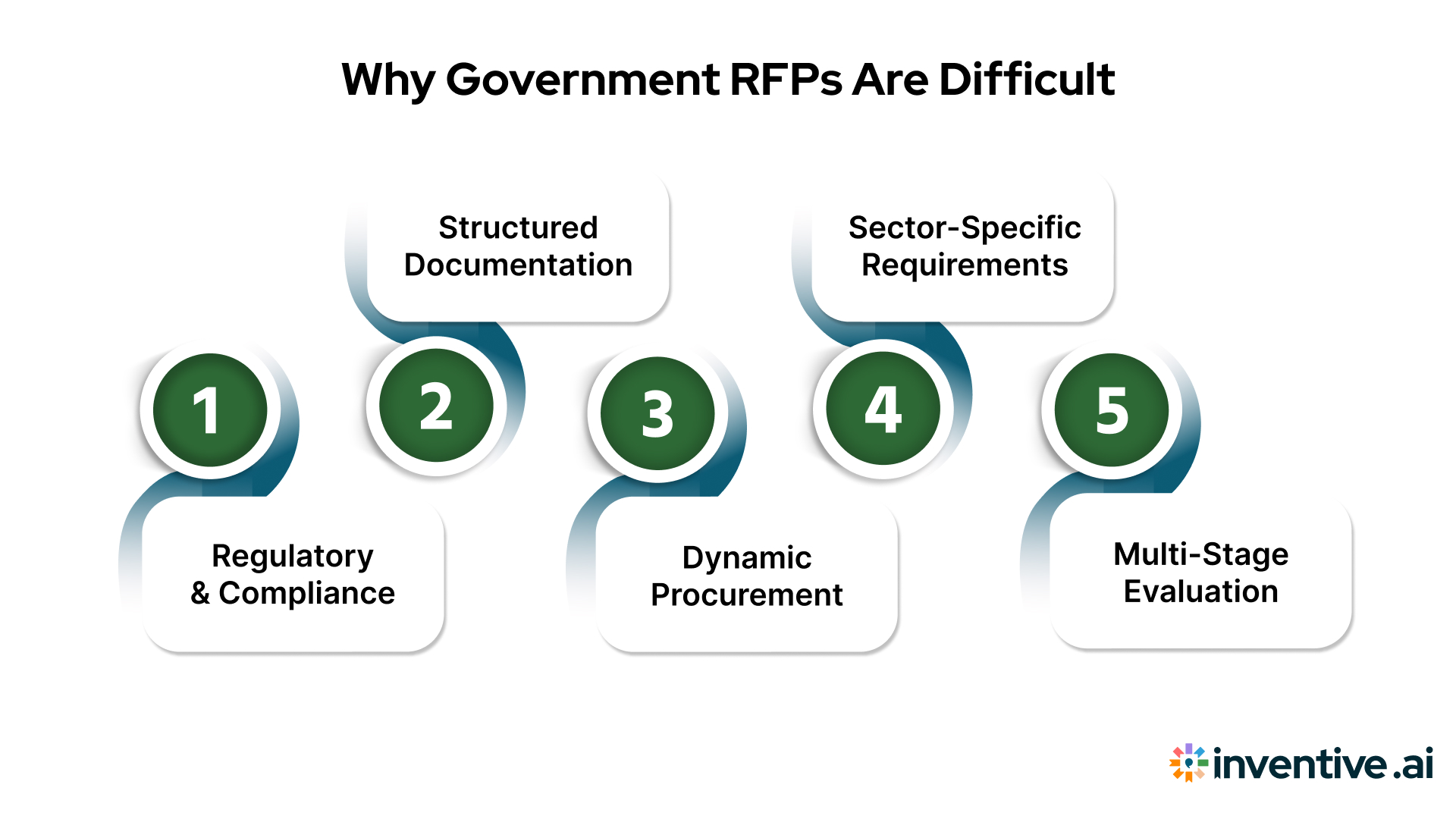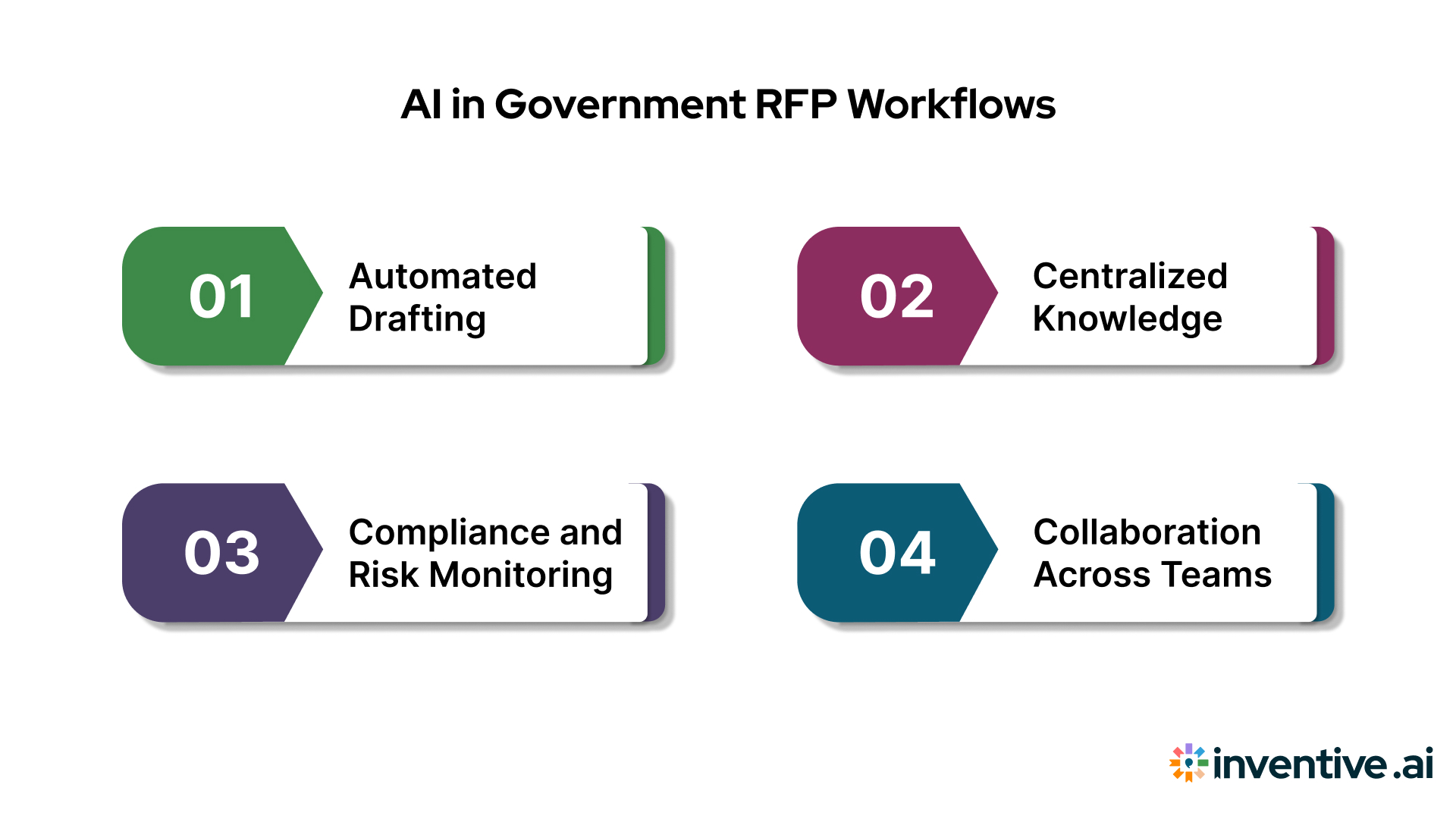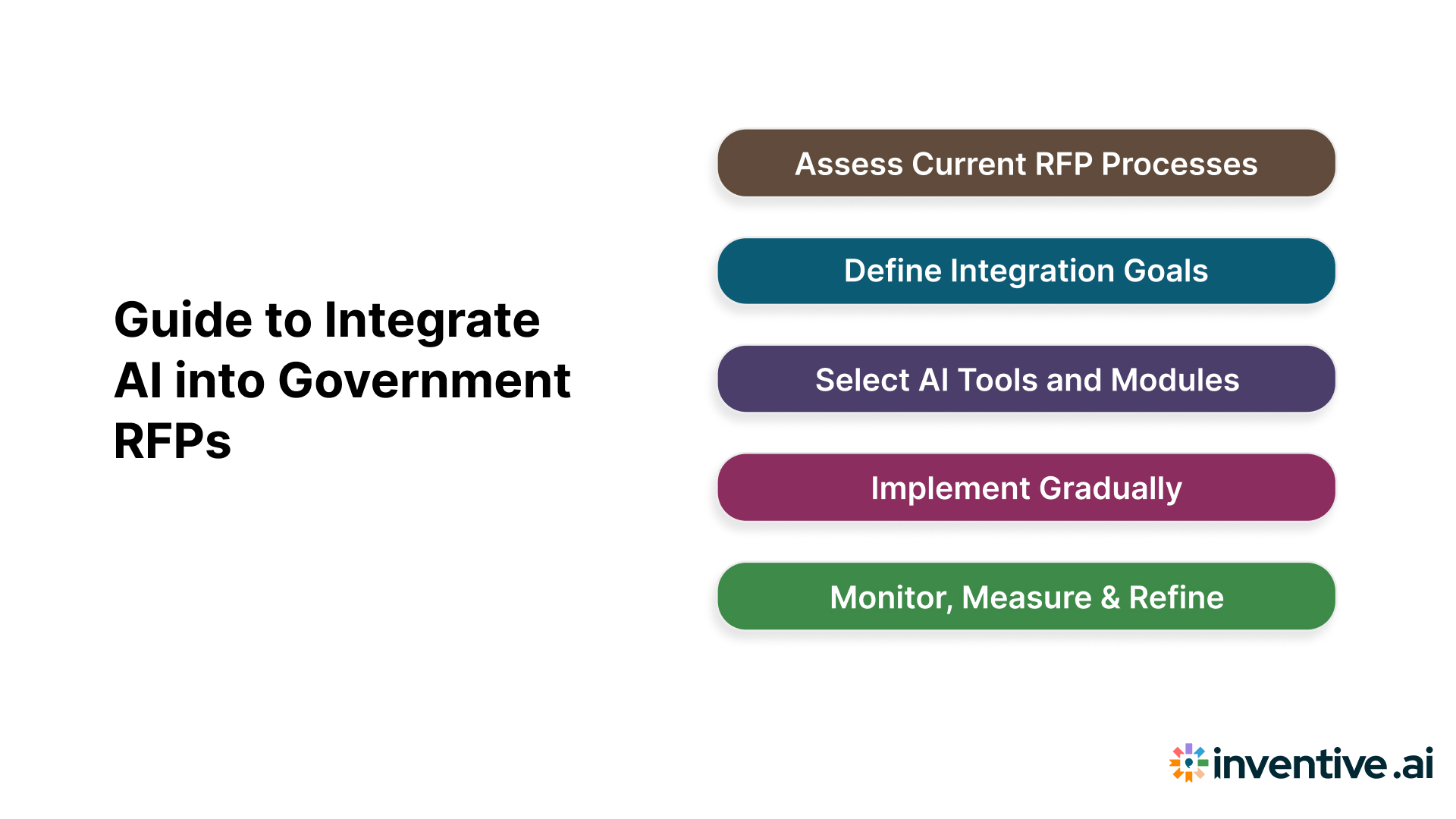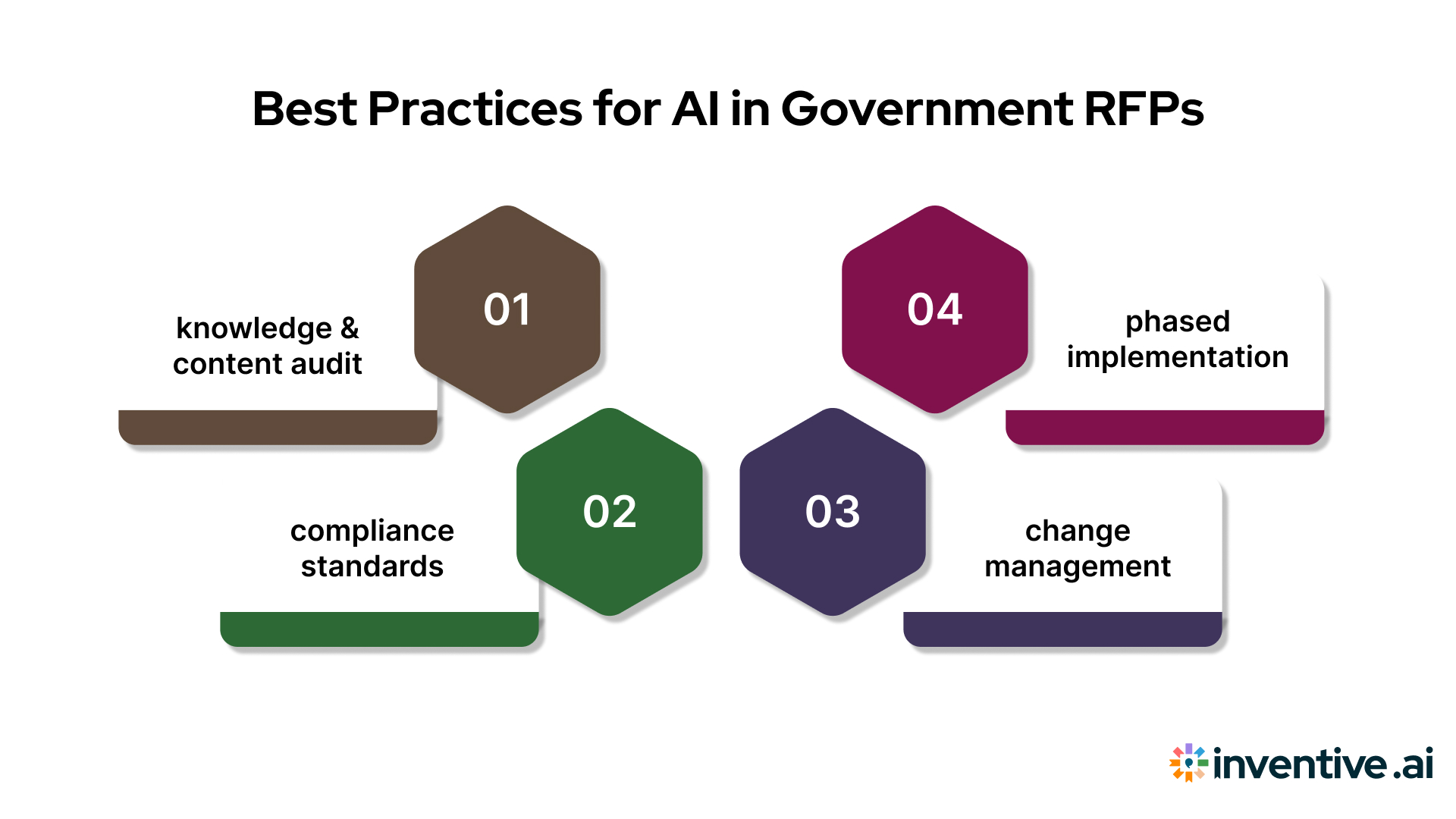Integrating AI Automation for Government RFP: A Comprehensive Guide
Master API contract RFP with AI! Define goals and endpoints, verify security, and outline compliance. Click to streamline integration.

Did you know that federal government contracting reached approximately $759 billion in FY2023? This enormous market presents a significant opportunity for organizations, but the path to winning government RFPs is fraught with challenges. Each proposal must meet strict compliance requirements, include accurate information, and align with evaluation criteria.
Despite the high stakes, many teams still rely on manual processes to manage RFP responses—tracking past proposals, reviewing documents, and drafting responses by hand. This approach slows response times, increases the risk of errors, and diverts valuable resources from strategic tasks.
Integrating AI-driven automation directly addresses these challenges. By centralizing knowledge, flagging compliance issues, and generating accurate drafts efficiently, AI enables teams to produce high-quality, compliant RFP responses faster. This guide serves as a comprehensive roadmap for organizations seeking to leverage AI automation to improve government RFP workflows and increase their win rates.
Key Takeaways
- Explore the key challenges of government RFPs, including complex documents, strict compliance rules, multiple stakeholders, and the operational risks of manual management.
- Learn how AI automation accelerates drafting, improves accuracy, ensures compliance, and streamlines collaboration across teams.
- Gain a step-by-step guide on integrating AI into your RFP workflows to achieve faster, more consistent, and higher-quality responses.
- Discover best practices for successful AI adoption in government RFP processes, maximizing efficiency and measurable outcomes.
Understanding Government RFPs and Their Challenges
Government procurement often begins with structured requests such as RFPs (Requests for Proposal), RFIs (Requests for Information), RFQs (Requests for Quotation), and security questionnaires. Each serves a distinct purpose: RFIs gather preliminary information, RFQs solicit pricing for specific goods or services, RFPs request comprehensive proposals, and security questionnaires assess vendor compliance with regulatory and cybersecurity standards.
Government agencies use several standardized procurement instruments, each with a distinct purpose in vendor evaluation:
These documents are more than administrative steps—they determine which vendors move forward and influence contract award decisions. Failing to understand each document’s purpose can result in disqualified submissions or misaligned responses.
Why Government RFPs Are Challenging

Government procurement is designed to be thorough and transparent, but that thoroughness comes with inherent complexity.
Agencies must ensure compliance with regulations, maintain fairness among vendors, and capture detailed technical and financial information. This makes the RFP process highly structured and demanding for any organization trying to respond accurately.
- Regulatory and Compliance Layers: Government RFPs must adhere to federal, state, and sector-specific rules. Defense, healthcare, and infrastructure projects often include strict audit requirements and layered compliance standards, making each submission highly regulated.
- Extensive and Structured Documentation: A single RFP can span hundreds of pages with multiple annexes, templates, and references. Every section has prescribed formats, evaluation rubrics, and submission protocols.
- Dynamic Procurement Rules: Rules and scoring methodologies frequently change. Agencies may introduce new evaluation criteria, eligibility requirements, or mandatory certifications, which must be incorporated accurately in each response.
- Sector-Specific Micro-Requirements: Certain industries, such as defense and healthcare, impose highly specific technical and operational requirements. These micro-requirements often affect eligibility, scoring, or contractual compliance.
- Multi-Stage Evaluation and Weighted Scoring: Responses are assessed across technical, financial, and compliance dimensions. Each criterion carries weight, and missing even minor specifications can disqualify a submission.
Automation can directly address these challenges by improving the accuracy of each response and maintaining consistent standards across all documents. Next, we will explore the specific ways AI interacts with each stage of the RFP process, showing exactly how these complex tasks can be executed with precision.
Role of AI in Government RFP Workflows

Government RFPs involve high volumes of complex documents, strict compliance rules, and multiple stakeholders. Integrating AI into these workflows transforms the process from a manual, error-prone task into a structured, efficient operation.
Integrating AI into these workflows transforms RFP management into a structured, efficient operation. According to McKinsey, AI agents can produce high-quality content, reducing review cycle times by 20 to 60 per cent. This acceleration allows teams to draft responses faster, maintain consistency, and focus on strategic aspects of proposals rather than repetitive tasks.
The following breakdown illustrates how AI achieves these outcomes in practical terms:
Automated Drafting and Content Generation
AI can automatically generate initial drafts of RFP responses by analyzing the RFP requirements and referencing prior submissions or internal templates.
How it works:
- Parses RFP sections and identifies mandatory fields.
- Pulls relevant content from a centralized knowledge base to populate standard answers.
- Maintains formatting and tone consistency across sections.
Why it matters:
- Reduces initial drafting time by up to 70% in complex government RFPs.
- Minimizes human errors in repeated or standardized content.
- Ensures all sections meet RFP guidelines without manual intervention.
Pro Tip: Maintain a library of pre-approved responses for commonly requested information. This allows AI to auto-populate sections while ensuring compliance and brand consistency.
For more details on how to use AI for drafting a Government proposal, check out our guide: Guide to Writing Government Contract Proposals with AI
Centralized Knowledge Management
AI consolidates historical RFPs, internal documentation, security questionnaires, and reference materials into a searchable, structured repository.
How it works:
- Indexes documents by keywords, regulatory references, and RFP types.
- Suggests relevant content snippets based on the context of new RFP questions.
- Tracks updates to templates and reference material to ensure the latest versions are used.
Why it matters:
- Eliminates time lost searching across emails, drives, and shared folders.
- Reduces duplication of work across teams.
- Provides new team members with rapid access to institutional knowledge.
Pro Tip: Tag documents by compliance requirements, agency, and sector to allow targeted retrieval, especially for highly regulated industries like defense or healthcare.
Compliance and Risk Monitoring
AI monitors responses against regulatory and security requirements, highlighting potential gaps or deviations.
How it works:
- Cross-references RFP requirements with industry regulations, contract clauses, and internal policies.
- Flags missing or outdated certifications, attachments, or disclaimers.
- Generates alerts for sections requiring human review before submission.
Why it matters:
- Reduces the risk of disqualification due to non-compliance.
- Saves legal and compliance teams hours of manual review.
- Provides an audit trail of changes for accountability and reporting.
Pro Tip: Incorporate compliance scoring for each response to prioritize sections that carry the highest risk or regulatory impact.
Collaboration Across Multi-Functional Teams
AI enables seamless coordination across teams such as sales, legal, finance, and technical experts.
How it works:
- Tracks edits in real-time without creating multiple conflicting versions.
- Assigns tasks automatically based on role or expertise.
- Integrates commenting and review functions so teams can converge efficiently on a single document.
Why it matters:
- Reduces bottlenecks caused by email chains or document version conflicts.
- Ensures all contributions are captured accurately and in context.
- Shortens overall response cycles while maintaining quality and accountability.
How can AI be effectively integrated into the complex landscape of government RFPs? The following step-by-step guide walks through each stage, showing how tasks can be automated and coordinated for accuracy and speed.
Step-by-Step Guide to Integrating AI into Government RFPs

Government RFPs involve multiple teams, tight deadlines, and strict compliance requirements. Integrating AI into these processes requires a structured, actionable approach that aligns technology with existing operations.
1. Assess Current RFP Processes
- Map existing RFP workflows across departments such as legal, technical, finance, and sales.
- Identify pain points like manual drafting, compliance errors, fragmented knowledge, and slow approvals.
- Determine which tasks are high-impact for AI automation (e.g., content generation, compliance checks, task coordination).
Pro tip: Document current bottlenecks with metrics like average response time or error rates to measure AI impact later.
2. Define Integration Goals
- Clarify desired outcomes like faster response times, higher win rates, better compliance adherence, or reduced manual effort.
- Prioritize AI capabilities based on goals, such as predictive content suggestions, gap analysis, or real-time collaboration.
3. Select AI Tools and Modules
- Evaluate AI solutions based on features relevant to government RFPs:
- Automated drafting and template management
- Centralized knowledge repositories
- Compliance and risk monitoring
- Collaborative editing and version control
- Ensure compatibility with existing software (CRM, document management, and project tracking tools).
Example: Choose a platform that integrates with your internal document repository to avoid duplicated content and maintain version control.
4. Implement Gradually
- Start with high-priority, low-risk tasks (e.g., content suggestions or draft pre-population).
- Expand to compliance monitoring and cross-team collaboration once initial adoption is stable.
- Establish training sessions for all users to ensure a smooth transition and consistent usage.
5. Monitor, Measure, and Refine
- Track AI impact using KPIs like response time reduction, content accuracy, compliance adherence, and team efficiency.
- Collect feedback from each team to identify gaps or additional opportunities for automation.
- Continuously update templates, rules, and AI recommendations based on evolving government regulations and internal standards.
Pro tip: Use analytics dashboards to visualize efficiency improvements and highlight bottlenecks for further optimization.
With AI fully integrated into government RFP processes, organizations can move beyond simply managing tasks. Automation begins to generate measurable impact across speed, accuracy, productivity, and competitive positioning.
Building the Business Case: Measuring the ROI of AI in Your RFP Process
Integrating AI into your RFP process can drive significant cost savings, improve win rates, and reduce compliance risks. Here’s how you can measure the ROI of adopting AI automation for your RFP workflows.
- Quantifying Time Savings: AI can significantly reduce time spent on RFP drafting and review by automating repetitive tasks, enabling teams to focus on high-value activities.
Formula: (Average hours per RFP - AI-assisted hours) x Hourly rate x # of RFPs per year = Total Savings
Example: If AI saves 20 hours per RFP at $50/hour for 100 RFPs annually, the total savings equals $100,000 in reduced labor costs. - Impact on Win Rate: AI enhances the quality and consistency of responses, which leads to higher win rates. By speeding up the process and ensuring compliance, proposals are more likely to meet all criteria and stand out. Studies show AI can boost win rates by up to 50% by improving both the speed and accuracy of responses.
- Reducing Compliance Risk: AI helps identify gaps in compliance, such as missing certifications or outdated clauses, preventing costly mistakes. By ensuring compliance with the latest regulations, AI can avoid fines, disqualification, and potential reputational damage. This cost-avoidance reduces the likelihood of missing contract opportunities or facing legal consequences.
Managing Data Security and Compliance with AI
Government RFPs often involve highly sensitive information — from confidential project details to personal data of citizens. Any AI-enabled proposal platform must demonstrate airtight security and full compliance with government standards. Buyers need assurance that automation will not compromise confidentiality or compliance obligations.
Key Security and Compliance Considerations
- Data Encryption: Ensure all data is encrypted both in transit (TLS/SSL) and at rest (AES-256 or equivalent). This prevents unauthorized access at every stage.
- Access Controls: Role-based permissions, SSO, and MFA ensure only authorized personnel can view or edit sensitive content.
- Audit Trails: Comprehensive activity logs create accountability and support regulatory audits.
- Compliance Standards: Platforms should align with frameworks relevant to government procurement, such as FedRAMP, FISMA, ITAR, SOC 2, and ISO 27001.
- Data Residency: For government contracts, data often must remain within specific geographic boundaries. Confirm your vendor provides regional hosting options.
By choosing an AI proposal solution that prioritizes compliance and embeds rigorous security protocols, government agencies and contractors can adopt automation confidently, knowing sensitive information remains protected.
Also Read: AI in Government RFP Workflow: Tips and Examples
Key Benefits of AI RFP Automation
AI-driven RFP automation transforms how vendors respond to complex government solicitations. By reducing manual effort and introducing intelligent oversight, teams can focus on strategic content and decision-making rather than repetitive administrative tasks.
- Faster Response Times: Pre-populates templates and suggests relevant content based on past submissions, reducing response cycles and enabling simultaneous multi-team collaboration to cut submission time significantly.
- Enhanced Accuracy and Consistency: Enforces compliance rules, flags missing or inconsistent information, standardizes language across sections, and aligns responses with historical RFPs to minimize errors and resubmissions.
- Increased Productivity and Efficiency: Centralizes historical RFPs, references, and regulatory guidelines for easy access, prevents duplicated work through coordinated collaboration, and reduces repetitive tasks, freeing teams for higher-value activities.
- Competitive Advantage in Government Bidding: Allows teams to focus on differentiators, strategy, and high-quality content rather than administrative tasks, improves credibility with faster, more accurate submissions, and provides insights to outperform competitors.
To realize these benefits, vendors must adopt structured approaches that ensure compliance, team readiness, and measurable outcomes. The following best practices provide a roadmap for integrating AI effectively into government RFP processes.
Implementation Best Practices for AI in Government RFPs

Adopting AI for government RFPs offers significant advantages, but success requires more than just deploying technology. Vendors must integrate AI in a way that preserves compliance, aligns teams, and leverages existing knowledge effectively. Structured implementation ensures that automation enhances efficiency without introducing risk, while setting the stage for measurable improvements in response quality and speed.
1. Conducting A Knowledge and Content Audit
Begin by evaluating all existing RFP-related documents, templates, and historical submissions. Identify reusable content, outdated materials, and gaps that need standardization. A thorough audit ensures AI systems draw from accurate, compliant sources, accelerating future responses while maintaining quality.
2. Aligning With Compliance and Security Standard
Government RFPs are bound by strict regulatory requirements. Ensure AI workflows adhere to relevant standards, such as federal acquisition rules, data privacy regulations, and internal audit protocols. Implement validation checks, version control, and approval layers to maintain a secure and auditable response process.
3. Team Training and Change Management
Success depends on cross-functional adoption. Train teams on AI-assisted processes, emphasizing roles, responsibilities, and best practices. Encourage feedback loops and internal champions to drive adoption.
4. Pilots and Phased Implementation
Begin with low-risk or smaller-scale RFPs to test AI capabilities. Define KPIs such as response time reduction, error rates, and team satisfaction. Use pilot results to refine workflows and scale integration incrementally, ensuring adoption is controlled and measurable.
5. Maintaining Human Oversight and Ethical AI Use
While AI accelerates drafting and streamlines compliance, it should never operate unchecked in government RFPs. A human-in-the-loop review process ensures every response is factually accurate, aligned with the agency’s expectations, and written in the appropriate tone. Proposal managers, subject matter experts, and compliance officers should validate AI-generated content before submission. This safeguards against errors, reinforces ethical use of AI, and preserves accountability in high-stakes government contracting.
Pro tip: Document lessons learned in each phase to continuously optimize AI-assisted processes.
How Inventive AI Transforms Government RFP Management
Integrating Inventive AI into your RFP process amplifies efficiency, accuracy, and win potential across every stage. By combining centralized knowledge management, intelligent drafting, and proactive content oversight, Inventive AI turns complex government RFPs into structured, high-performing responses.
- 10X Faster Drafts With Highly Accurate Responses: Inventive AI’s proprietary system accelerates first drafts up to ten times faster than traditional methods. Each draft leverages your organization’s knowledge sources, ensuring accuracy while enabling seamless collaboration to refine content.
- Single Hub for All Your Knowledge Sources: All RFP-related documents, templates, and legacy data converge in one centralized hub. Integrations with platforms like Google Drive, SharePoint, spreadsheets, and even websites allow your team to access, search, and reuse content efficiently.
- Fight Stale Content With AI Content Manager: Inventive AI proactively identifies outdated or conflicting content within your knowledge base, guaranteeing that every RFP response uses fresh, relevant, and consistent information.
- AI Agents for Competitive Advantage: A suite of AI agents supports tasks like competitor research, content brainstorming, and response optimization. By automating repetitive work, your team can focus on strategy and differentiators that increase your win potential.
- Win Themes for Maximized Conversion: Inventive AI identifies gaps in RFP responses and automatically gathers supplemental content from sources like Slack, emails, and calls. This ensures each proposal is complete, persuasive, and aligned with client expectations, increasing the likelihood of winning each deal.
- Instant Checklist and Progress Tracking: Users can generate actionable checklists to ensure all critical components of an RFP are addressed. Progress can be monitored post-submission to continually refine processes and improve outcomes.
Transform your government RFP responses with Inventive AI, the AI RFP Agent that delivers faster, more accurate, and high-impact submissions, boosting your win potential and team productivity.
Conclusion
Government RFPs are inherently complex, with stringent compliance requirements, tight deadlines, and high stakes for every submission. This guide has demonstrated how integrating AI-driven solutions can accelerate response times, improve accuracy, and enhance productivity. By centralizing knowledge, automating repetitive tasks, and providing actionable insights, organizations can consistently produce high-quality, compliant proposals that align with client expectations.
For CFOs, VPs of Sales, and decision-makers seeking measurable impact, Inventive AI delivers a transformative approach to RFP management. Its AI-powered RFP response software ensures faster drafts, smarter content management, and optimized workflows, freeing teams to focus on strategy, differentiation, and deal-winning insights.
Ready to streamline your RFP response process and increase win rates by over 50%? Request a demo and see how Inventive AI can revolutionize your proposal management today.
FAQs
1. How does AI streamline government RFP responses?
AI reduces manual drafting and review time by automatically generating structured responses, pulling from previous submissions, templates, and knowledge bases. This allows teams to submit faster while maintaining accuracy.
2. Can AI help ensure compliance with government regulations?
Yes. AI can analyze RFP requirements, flag compliance risks, and suggest improvements, helping teams meet strict government standards and minimize errors in submissions.
3. What productivity benefits can AI bring to RFP management?
AI automates repetitive tasks, organizes documents, and centralizes knowledge sources, enabling teams to focus on strategy, differentiators, and high-quality content rather than administrative work.
4. Will using AI improve win rates in government bidding?
AI ensures consistency, accuracy, and faster response times, which allows teams to submit higher-quality proposals. This, combined with strategic insights and content gap analysis, increases the likelihood of winning competitive bids.
5. Is AI integration in RFP processes difficult or disruptive?
When implemented correctly, AI can integrate seamlessly with existing workflows and knowledge repositories. Phased adoption and proper training ensure minimal disruption while delivering measurable efficiency gains.


